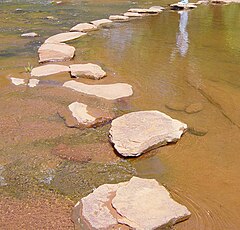
Back Passera de pedres Catalan Cerrig llam Welsh Trittstein German Paŝoŝtonoj Esperanto Harpauso Basque سنگراهه Persian Pierres de gué French Pasadoiro Galician גשר אבני מדרך HE Stiklusteinabrú Icelandic
This article needs additional citations for verification. (January 2008) |
 A rustic stepping stone bridge across a stream. | |
| Ancestor | None, this is one of the few foundational types, but see also: ford (crossing). |
|---|---|
| Related | Natural stepping stone stream crossing |
| Descendant | Clapper bridge, Zig-zag bridge, Log bridge |
| Carries | Pedestrians |
| Span range | Has no spans, but stones must be spaced to allow water flow and a comfortable step or leap |
| Material | Selected stone |
| Movable | No |
| Design effort | Low-rustic to Artisan applied art design |
| Falsework required | No |
Stepping stones or stepstones are sets of stones arranged to form an improvised causeway that allows a pedestrian to cross a natural watercourse such as a creek, a small river; or a water feature in a garden where water is allowed to flow between stone steps.[1] Unlike bridges, stepstone crossings typically have no spans, although wood planks or stone slabs can be placed over between the stones (which serve as the piers) to improvise as low-water bridges. Although their historical origin is unknown, stepping stones, along with log bridges, are likely to have been among the earliest means of crossing inland bodies of water devised by humans.
In traditional Japanese gardens, the term iso-watari refers to stepping stone pathways that lead across shallow parts of a pond, which work like a bridge-like slower crossing. Using iso-watari for crossing ponds, or shallow parts of streams, one can view the aquatic animals and plants around or in the pond, like carp, turtles, and waterfowl.
Today, stepping stones are commonly used by mountaineers and hikers as a makeshift way of crossing uncharted or unanticipated streams and torrents. They may occur alongside a ford.
- ^ "Glossary of Trail and Greenway Terms". South Carolina State Trails Program. 2008. Retrieved 5 January 2014.